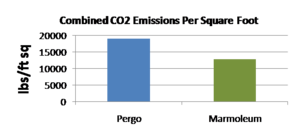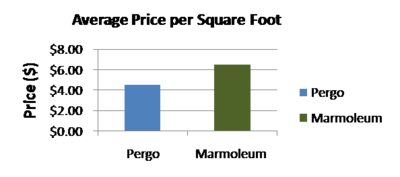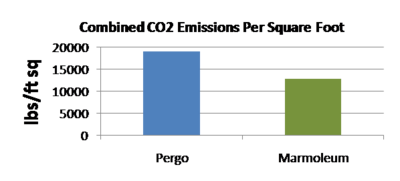
The purpose of this project was to determine whether laminate flooring or Marmoleum which is a brand of linoleum, has the least impact on the environment. We were asked by, Sean Armstrong, of Danco Construction in Arcata, California to measure this impact in terms of CO2. This spreadsheet can be considered by people looking for green flooring to base their decision on the information we have found about each products. Our research includes information on CO2 from transportation and production, as well as materials in which the floorings are composed of. The conclusion is up to the reader to decide which one is better than the other, depending on which aspect(s) the reader is more concerned about. Whether it be the production, transportation, or simply what materials each is composed of.
Background[edit | edit source]
The two major flooring brands included are; laminate flooring by Pergo and Marmoleum flooring by Forbo. Marmoleum is generally assumed more green and environment friendly than Pergo because they disclose tons of information about all stages of production on their website, whereas Pergo does not. Our client wants to find if in fact choosing Marmoleum is a more sound environmentally friendly choice. He is curious if the transportation, harvesting, and production of Marmoleum may outweigh its all natural ingredients. Pergo is considered a green product as well; however it is composed of some non-renewable resources.
Problem statement[edit | edit source]
Our groups put together an Excel workbook which shows the CO2 emissions released from transportation as well as production. CO2 is measured in lbs/kWh. They also include what materials the products are composed out of to show how much renewable resources they use. The distances from Pergo and Forbo's factories to their warehouses and then to Eureka, CA for Forbo Arcata, CA for Pergo are included for the CO2 released by transportation. The energy consumption for each company and the grid mix for those states where they are located are for the CO2 that is produced in that grid mix and how much is contributed by the factories. We did not include the energy consumed by the warehouses or the grid mix for the states the warehouses are in.
Instructions[edit | edit source]
Due to the request of our client the only variable users are able to change is the total square feet of the intened floor project. The rest is just a viewing of the results.
Justifications[edit | edit source]
Assumptions and references are located on the spreadsheet. Assumptions not on the spreadsheets are: we assumed that the warehouses would continue to consume the energy whether the flooring was there or not because warehouses usually store more than just one product. We also assumed that that energy for the warehouses if divided up would be minuscule to the rest of the inputs that it would have no effect on the outcome. Another important assumption was from our data for pounds of CO2 per square foot of Pergo flooring. This data came from a study which was done on European laminate flooring, so our assumption was that the production of European laminate was equal in terms of CO2 as laminate made in the US.
Results[edit | edit source]
(Media:MarmoleumvsPergoWorkbookfinal copy.xls)


Based on our results we have found that under the assumption of Marmoleum being produced in the United States, it has less of a carbon impact in terms of lbs CO2 per square foot of flooring. Figure 2 shows combined CO2 emissions from transportation and production. Although the producing Marmoleum and getting it to Arcata California may require less CO2 than that of Pergo, as a consumer you will on average be paying a higher price for the product (Figure 1).
Discussion[edit | edit source]
The main assumption that would affect our results the most would be that Marmoleum is coming out of Pennsylvania California. If in fact the Marmoleum is coming from Europe, which is where it originated, our results would change dramatically. We were surprised to find that Marmoleum did have a production plant here in the US, because going into this project we were under the impression that it only came out of Europe.
Both companies and products are recyclable. Marmoleum can be used in composting, they use the excess material at the factory and job site as compost to provide to the farmers as fertilizer since it is all-natural that. Even as it runs out of life as flooring, it can be removed and recycled. The Forbo Company also uses shipping materials, e.g. cardboard boxes and pallets, in their composting. Forbo tries to limit their footprint as much as possible and is successful at it. Pergo also recycles but it is not as much as Forbo because the materials are not all natural. The Pergo plants do use the excess materials as a form of energy. They burn unused material as a source of heat for the facility.
Next steps[edit | edit source]
We propose that the next steps to improve this study would be to quantify the energy necessary from extraction of the raw materials. This information was possible to find for Forbo's Marmoleum, however truly proved to be a difficult task for Pergo.
References[edit | edit source]
http://web.archive.org/web/20180816230817/https://oaspub.epa.gov/powpro/ept_pack.charts mts.sustainableproducts.com http://web.archive.org/web/20100216013902/http://www.eplf.com:80/downloads/eplf.2009311.eng.pdf .com/hub/Marmoleum-FlooringThe-New-Linoleum http://web.archive.org/web/20110524100612/http://hubpages .com/hub/Marmoleum-FlooringThe-New-Linoleum http://web.archive.org/web/20100328024055/http://www.flooroption.com:80/pergo-laminate-flooring.htm http://www.bobvila.com/HowTo_Library/Pergo_Factory_Tour-Subject_TV_Show_Tours-A1885.html Getwithgreen.com, online interview about Marmoleum http://www.contempofloorcoverings.com/flooring/marmoleum-floors/facts/ http://web.archive.org/web/20101028022515/http://www.forboflooringna.com:80/Default.aspx?MenuId=644 http://www.forboflooringna.com/ModuleFiles/mod_quick_download/275/FileName/ASBE_FORBO_LEED_EB_2009.pdf Carter, D T; Stansfield, N; Mantle, R J; France, C M; Smith, P A. "An Investigation of Epoxidised Linseed Oil as an Alternative to PVC in Flooring Applications." Industrial Crops and Products 28 (2008): 309-319.> Marmoleum_Product_Process.pdf http://products.construction.com/swts_content_files/151611/288097.pdf http://web.archive.org/web/20180816230817/https://oaspub.epa.gov/powpro/ept_pack.charts mts.sustainableproducts.com/.../Forbo/.../Forbo%20BEES%20Summary_final%20Converted.doc http://web.archive.org/web/20111117062957/http://www.1888pressrelease.com/uniboard-purchases-moncure-nc-facility-and-announces-new-md-pr-66022.html http://web.archive.org/web/20120904145347/http://www.dovetailinc.org/files/DovetailFloors0809.pdf